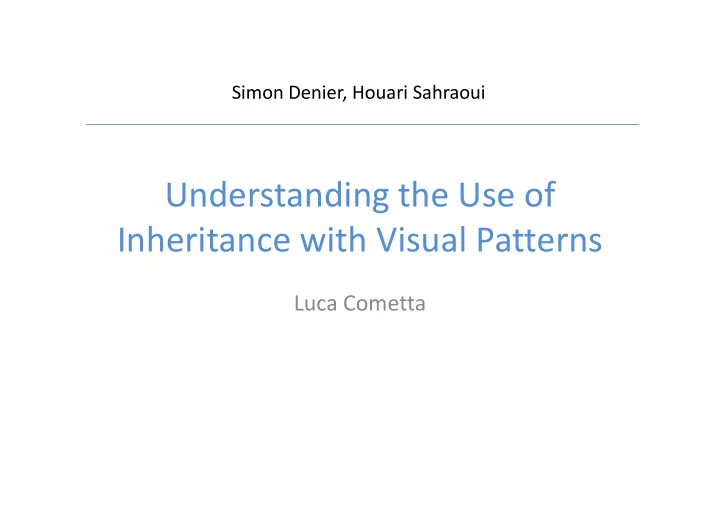

Simon Denier, Houari Sahraoui Understanding the Use of Inheritance with Visual Patterns Inheritance with Visual Patterns Luca Cometta
Motivation • Number of hierarchies • Depth • Size • Important classes • Important classes • Relationship between classes 2
VERSO • 3D objects • 2D plane • Classes as 3D boxes Visualization-based Analysis of Quality for 3 Large-scale Software Systems
Definitions of the Inheritance Notion Parent class : a class which has • subclasses Childless class : a class which has • no subclasses Family : the set of direct • subclasses of a parent subclasses of a parent Hierarchy : the full set of • subclasses of a parent Hierarchy root : the parent class • of a Hierarchy whose parent is Object Ghost class : a class which is • defined outside the project 4
Definitions of the Sunburst Layout Slice : a part of the visualization • delimited by edges Subslice : a slice on the outer • edge of the current slice Full Slice : a slice and all its • subslices subslices Eye : the innermost slice of the • visualization 5
Basic Metrics • Depth of Inheritance Tree: – The number of parent classes up to the root – The greater the DIT is, the farther the class is in the inheritance hierarchy • Number of Children: • Number of Children: – The greater the NOC is, the more responsibility the class has • Number of Methods – The greater the NOM is, the more services the class can offer to the program – Mapped to height 6
Subclassing Behaviour 7
Children Similarity • Based on similarity of the method signatures • Prototype is computed • Similarity to prototype is computed • Mapped to Twist • Similar children are vertical • Dissimilar children are horizontal 8
A First Example: JHotDraw A: Swing framework extension B: High use of overriding for polymorphism for polymorphism C: Main hierarchy of class Figure 9
Visual Patterns • Large Root : root slice with a large radius • Big Hierarchy : full slice with deeply nested slices and slices with many entities or subslices subslices • Common Family : red parent and mostly blue children 10
Polymorphic Hierarchies • Large Family : a slice with many entities, often childless • Similar Children : a slice with many vertical entities • Nested Families : nesting of the previous patterns • Nested Families : nesting of the previous patterns • Library / Framework Extension : full slice with nested ghost parents parenting entities of mixed properties • Exception Hierarchy : Full slice with nested ghost parents and a majority of purple entities 11
Program Analysis A three-step process: 1. An overview of inheritance use is provided to answer general questions answer general questions 2. Focus on particular classes or hierarchies to identify visual patterns 3. For each particular case it‘s possible to request more information 12
Case Study 1: JFreeChart • Many nested slices A: AbstractDataSet • Rather small hierarchies • Many red entities B: AbstractRenderer • Three big hierarchies • Entries display mixed properties properties • Two big slices • Many tall classes in A • C: Swing framework C extension • Horizontal twist of purple entities in the eye 13
Case Study 2: Xalan SyntaxTreeNode • Many slices • The eye is relatively small DTMAxisIteratorBase • Slices are deeply nested with large root slices • Entities are mostly blue • Entities are mostly blue • A and E show strong polymorphic patterns • B, C and D display mixed polymorphic hierarchies • F matches the exception Expression hierarchy pattern UnImplNode Resource Bundle 14
Case Study 3: Azureus Big eye • Few big hierarchies TableColumnImpl • Most hierarchies are shallow • Blue and red entities are mixed • DERObject A is a big hierarchy used to • encode basic datatypes The other big hierarchy is the The other big hierarchy is the • • exception hierarchy E C is unusual: similar children • implementing the same interface ( TableCellRefreshListen er ) D and F are occurences of • ResourceDownloader GeneralDigest BaseImpl polymorphic families 15
Conclusion • Scalable inheritance visualization • Display many characteristics of inheritance at program aswell as at class level • Developed a new metric for child similarity • Developed a new metric for child similarity • Major limitation: single inheritance • Sunburst layout can display improper effects 16
Questions? ? 17
Recommend
More recommend